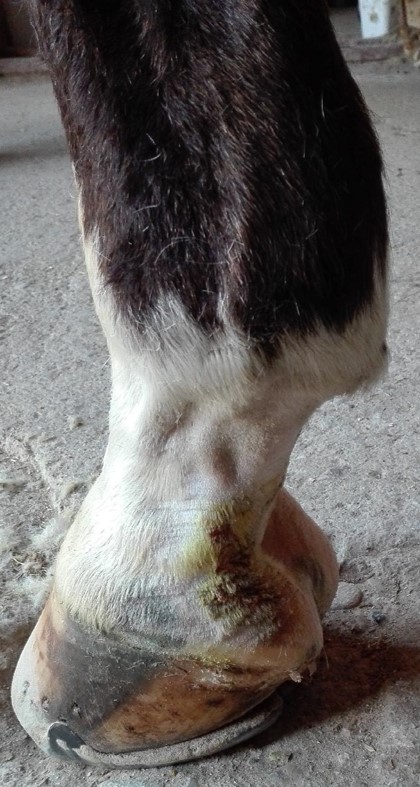
Styková E. Leukocytoklastická vaskulitída sponky a holene u koňa. Veterinářství 2019;69(9):579-583.
SOUHRN
Leukocytoklastická vaskulitída sponky a holene je málo pochopeným ochorením a postihuje predovšetkým dospelé kone na pastve počas leta. Boli sme privolaní k 14ročnému valachovi plemena slovenský teplokrvník kvôli léziám na distálnych častiach končatín, ktoré odolávali terapii. Nástup príznakov bol akútny, lézie boli spočiatku bolestivé na dotyk, postupne sa pomaly šírili, došlo k edému končatín. Každé lokálne ošetrenie viedlo k zhoršeniu stavu. Postihnuté boli výlučne nepigmentované oblasti kože na distálnych častiach dvoch z troch bielych končatín. Lézie boli dobre ohraničené, približne kruhové, erytematózne, exsudatívne, s pevne adherovanými chrastami, nebolestivé, nepruritické. Ďalšie klinické vyšetrenie bolo bez relevantných nálezov. Majiteľke bolo doporučené, aby boli končatiny udržiavané v čistote a suchu. Vždy pred vyvedením koňa z boxu na denné svetlo a na pastvu bol na postihnuté končatiny navlečený dobre padnúci pruban, ktorý prekrýval aj pätky a korunkový okraj kopýt. V prípade práce pod sedlom boli postihnuté oblasti starostlivo bandážované a na kopytá nasadené zvony. Po týchto opatreniach došlo k postupnému výraznému zlepšeniu a ústupu lézií. V závažnejších prípadoch je nevyhnutné v úvode nasadiť vysoké dávky systémových kortikosteroidov, pri signifikantnom edéme končatín môže byť nápomocná antimikrobiálna liečba.
SUMMARY
Pastern and cannon leukocytoclastic vasculitis is a poorly understood disease and mainly affects adult horses in the summer. We were called to a 14-year-old Slovak warmblood gelding due to lesions on the distal parts of the limbs that resisted therapy. The onset of symptoms was acute, the lesions were initially painful to the touch, gradually spread and limb edema occurred. Each local treatment resulted in deterioration. Exclusively non-pigmented areas of the skin on the distal parts of two of the three white limbs were affected. The lesions were well circumscribed, approximately circular, erythematous, exsudative, with firmly adhered crusts, painless, non-pruritic. Further clinical examination was without relevant findings. The owner was advised to keep the limbs clean and dry. Always before the horse was taken out of the stable to daylight and pasture, the well-fitting socks, which overlapped also the heels and coronary band of the hooves, were put on the affected limbs. In the case of working under the saddle, the affected areas were carefully bandaged and bell boots were put on the hooves. After these measures, the lesions progressively improved and retreated. In more severe cases, high doses of systemic corticosteroids should be used at the outset, antimicrobial therapy may be helpful if significant limb edema is present.*